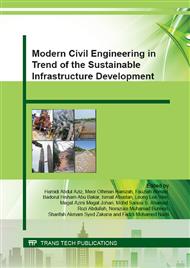[1]
Weiss, W. Bouwer, E. Ball, W. O'Melia, C. LeChevallier, M. Arora, H. Aboytes, R. and Speth, T., 2003. Study of water quality improvements during riverbank filtration at three Midwestern United States drinking water utilities, Geophys Res Abstr, p.04297.
DOI: 10.1007/0-306-48154-5_9
Google Scholar
[2]
Zandi, S. Ghobakhlou, A. and Sallis, P., 2011. Evaluation Of Spatial Interpolation Techniques For Mapping Soil pH. In 19th International Congress on Modelling and Simulation, Perth, Australia, 12-16 December (2011).
DOI: 10.36334/modsim.2011.c2.zandi
Google Scholar
[3]
Travaglia, C., 1998, Groundwater Exploration by Satellite Remote Sensing in the Syrian Arab Republic, Part 1, RSC Series 76, FAO (1998).
Google Scholar
[4]
Salama, R. Tapley, I. Ishii, T. Hawkes, G., 1994, Identification of Areas of Recharge and Discharge Using Landsat-TM Satellite Imagery and Aerial Photography Mapping Techniques, J Hydrol 162: 119–14.
DOI: 10.1016/0022-1694(94)90007-8
Google Scholar
[5]
Bobba, A. G. Bukata, R. P. Jerome, J. H., 1992, Digitally Processed Satellite Data as a Tool in Detecting Potential Groundwater Flow Systems, J Hydrol 131: 25–62.
DOI: 10.1016/0022-1694(92)90212-e
Google Scholar
[6]
Mas, J. F., 1999. Monitoring Land-Cover Changes: A Comparison of Change Detection Techniques. International Journal of Remote Sensing, 20 (1), pp.139-152.
DOI: 10.1080/014311699213659
Google Scholar
[7]
McVicar, T. R. Briggs, P. R. King, E. A. and Raupach, M. R., 2003. A Review of Predictive Modelling From a Natural Resource Management Perspective: The Role of Remote Sensing of the Terrestial Environment. CSIRO Land and Water Client Report to the Bureau of Rural Sciences (also available as CSIRO Earth Observation Centre Report 2003/03 and CSIRO Atmospheric Research Report 2003/31). Canberra, Australia.
Google Scholar
[8]
Brail, R. K. and Klosterman, R. E., 2001. Planning Support Systems: Integrating Geographic Information Systems, Models, and Visualization Tools. Esri Press.
Google Scholar
[9]
Hopkins, L. D., 1977. Methods For Generating Land Suitability Maps: A Comparative Evaluation. Journal of the American Institute of Planners, 43(4): 386-400.
DOI: 10.1080/01944367708977903
Google Scholar
[10]
Srisuk, K. Archwichai, L. Pholkern, K. Saraphirom, P. Chusanatus, S. Munyou, S., 2012. Groundwater Resources Development by Riverbank Filtration Technology in Thailand, International Journal of Environmental and Rural Development, 3(1): 155-161.
Google Scholar
[11]
Azmi, I., 2013. Interview with the author. Kuala Kangsar, 28 Mac 2013. [En Azmi Ismail is a site engineer from Da-Joo Construction Co Ltd Malaysia responsible for RBF project in Kota Lama Kiri, Kuala Kangsar, Perak].
DOI: 10.4028/www.scientific.net/amm.802.634
Google Scholar
[12]
Chave, P., Howard, G., Schijven, J., Appleyard, S., Fladerer, F., Schimon, W., Schmoll, O., Chilton, J. and Chorus, I., 2006. Groundwater Protection Zones. Protecting Groundwater For Health: Managing The Quality Of Drinking-Water Sources: 465-492.
DOI: 10.2166/9781780405810
Google Scholar
[13]
Aguilar, M. A. Saldaña, M. M. Aguilar, F. J., 2013. GeoEye-1 and WorldView-2 Pan-Sharpened Imagery For Object-Based Classification in Urban Environments, International Journal of Remote Sensing, 34(7): 2583-2606.
DOI: 10.1080/01431161.2012.747018
Google Scholar
[14]
Fröhlich, B. Bach, E. Walde, I. Hese, S. Schmullius, C. Denzler, J., 2013. Land Cover Classification of Satellite Images Using Contextual Information, In ISPRS Annals of the Photogrammetry, Remote Sensing and Spatial Information Sciences, Volume II-3/W1, 2013 VCM 2013 - The ISPRS Workshop on 3D Virtual City Modeling, 28 May 2013, Regina, Canada.
DOI: 10.5194/isprsannals-ii-3-w1-1-2013
Google Scholar
[15]
Myint, S. W. Gober, P. Brazel, A. Grossman-Clarke, S. Weng, Qihao., 2011. Per-Pixel vs. Object-Based Classification of Urban Land Cover Extraction Using High Spatial Resolution Imagery, Remote Sensing of Environment, 115(5): 1145-1161.
DOI: 10.1016/j.rse.2010.12.017
Google Scholar
[16]
Perea, A. J. Meroño, J. E. Aguliera, M. J., 2009. Algorithms of Expert Classification Applied in Quickbird Satellite Images For Land Use Mapping, Chilean Journal of Agricultural Research, 69(3): 400-405.
DOI: 10.4067/s0718-58392009000300013
Google Scholar
[17]
USM LRGS Report., 2014. Protection of Drinking Water For Society: Source Abstraction and Treatment, Progress Report for 2nd year, Ministry of Education.
Google Scholar


